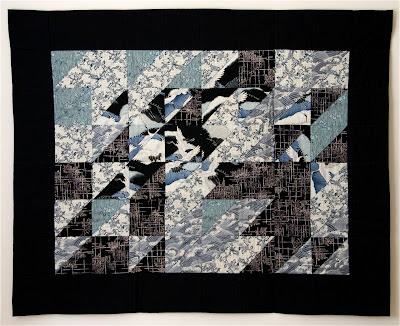At that time, the finished products from a Japanese quilting class taught by Lorraine Torrence happened to be hanging in the shop. The quilts used Japanese fabrics in half-square triangles arranged asymmetrically to create a send of flow and movement, and I immediately thought I could do the same on my own. When I got home, I immediately made my second quilt ever:
For the sake of variation, I used one square block, in addition to all of the half-square triangles. I planned all of the blocks in advance on graph paper with colored pencils.* In the end, I liked the result a lot, although I'm still a little ambivalent about what I think of as "the big black bat" in the lower right quadrant of the quilt.
When it came to quilting techniques, I knew absolutely nothing. I used stab stitches because I didn't understand how to make a running stitch, and since I had no concept of bindings, I finished the quilt by folding excess fabric from the front around to the back. I think I made at least four quilts before I learned how to make a binding. No mitered corners in the border either, which helped ensure that the borders stretched more than they ought to have.
Even so, I'm still fond of this quilt, flaws and all.
*For my third quilt (alas, no longer in my possession), I did another "Japanese-style" quilt with half-square triangles, but I tried for spontaneity and initially laid out all of the triangles completely randomly. The result was a complete mess--an important lesson in design and how improvisation and randomness aren't anywhere near the same thing. A coherent design with a simultaneous sense of movement and order required a lot of rearranging, planning, and experimentation.



No comments:
Post a Comment